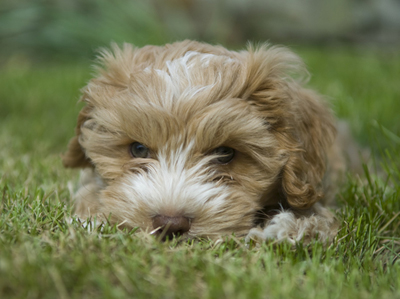Find out more about The Open University's Biology qualification.

When an interesting or useful trait is identified in a dog, owners would breed from that dog in the hope of the trait being passed on. Over many rounds of such breeding attempts, especially where two dogs with the same trait are bred with each other, traits became fixed. If you understand the genetics, you can predict what you can see in a crossbreed.
There are over 400 breeds of dog in the world and all are maintained as pure-bred stocks through selective breeding, which aims to maintain a closed genetic lineage. Most dog traits follow simple genetic rules.
Traits are often referred to as being dominant or recessive. Just like humans, dogs have two copies of each gene (one inherited from mum and one from dad), but the letters making up each gene can be slightly different. If a gene influences for a particular trait (such as hair colour) then slight differences in the letters in a gene can result in differences in hair colour in that animal. Some of these differences dominate over others, so that particular variant of the gene is described as being dominant. In this case, the hidden trait is called recessive. Occasionally, a dog inherits two genes for a recessive trait and you get a surprise!
Some traits and their dog genes:
- IGFR1: A common recessive variant in this gene can result in a small dog, but only if two copies are present.
- FGF4: A variant letter in this gene has the dominant effect of shortening leg length, so any dog with one copy from either mum or dad will have short legs.
- FOXI3: Causes hairlessness and also affects teeth, commonly seen in hairless Mexican, Peruvian, and Chinese crested dogs. In these cases the dogs have one copy of the mutant Foxi3 gene, which means that they have one copy of the normal gene as well. Dogs with two copies of the gene do not survive, so we never see these. If you breed two hairless dogs, some of the offspring will actually inherit two normal genes and will have normal hair, for example, for Chinese crested dogs these are called powder-puffs.
Dog hair types are influenced by variant DNA letters in at least three genes: some FGF5 variants cause silky long hair in dogs such as cocker spaniels, pomeranians and long-haired chihuahuas; variants in the KRT71 can lead to curly hair and the RSP02 gene influences the formation of wiry hair, such as that seen in terriers and schnauzers. In combination, the effect when all three are found together is a coat like a poodle.
In many cases, the effects of differences in other genes can influence each other. For example, many varieties of dog coat colours and patterning behave like this, so predicting the exact colours of offspring can be hard as there are many combinations possible. Breed standards are often used to define a breed and are used to maintain a particular combination of gene versions and combinations.
Other traits get carried along with the blocks of genetic material on a chromosome housing a gene for a particular trait. Many of which are not wanted or even desirable. Hence many dogs also develop unusual diseases (many of which look very similar to human diseases). Many develop disease including heart disease, cataracts, cancers, deafness and hip dysplasia. This is because genetic mutations that cause these have also been carried along or fixed into these breeds through continual selective breeding.
One example of this is a gene on the X chromosome which leads to a type of muscular dystrophy similar to the human Duchene muscular dystrophy. Dogs that often develop this include golden and Labrador retrievers and Rottweilers. As male dogs only have the one copy of the X chromosome, they are more prone to this disorder.
See selective breeding in action
Try some selective breeding of your own with the Angel Breed game. Just like dogs, you can selectively breed angelfish with defined traits.
Take the fin shape as an example, it comes in three varieties (normal, veil and superveil). If every single fish in your tank had the same set of genes, then each time you breed a pair the fin would not change form. So, for example, if you want all your fish to have a superveil, then you need to aim to get fish that are VV only in your tank. You can do this by selling everything else. Once you have all VV fish, it doesn’t matter what combination of breeding pairs you try, they will all be VV as well (check the punnet square in the game instructions). This is a superveil ‘breed’, and while the other two genes can influence the colour and stripes of a fish, fish bred from a pair that both have VV will always remain superveil.
Tips:
- Aim to get the genetics right; if all your fish have the same two markers at one of the loci (boxes), they will always breed true.
- Here are two examples for you to try:
- Standard silver fish ( ++ ++ ++) are very easy to obtain. If you mate two fish they will only ever produce the same.
- Dark Gold Marble (superveil) has the following genes GMGM ZZ VV. If you have two and breed them, they will always only ever produce the same type of fish. Try to get a tank full of these valuable fish!







Rate and Review
Rate this article
Review this article
Log into OpenLearn to leave reviews and join in the conversation.
Article reviews